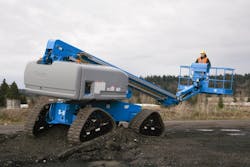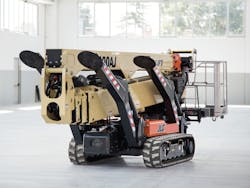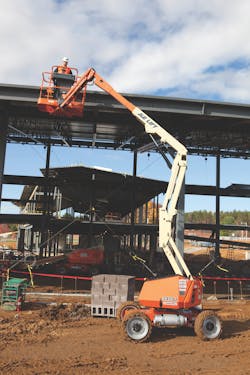What to look for in rough terrain boom lifts
Boom lifts (more recently monikered as MEWPs) have gained significant rough-terrain capabilities in recent years.
Although scissor lifts (another discussion) are explicitly referred to being "rough terrain," articulating and telescopic boom aerial lifts are usually not, unless they're tracked. That's because OEMs have baked in some rough-terrain capabilities, within limits, in their basic designs, mainly with tire and steering options, extra ground clearance, and safety features.
The inherent safety issues that boom lifts face can be magnified on rough terrain.
In general, boom lifts aren't recommended for use on a hill or incline. The center of gravity is higher than other machines, which increases the risk of a tip over. It is possible to work on a incline, however if the operator does not exceed the recommended maximum slope with a safe working load.
How to calculate slope rating
In addition to knowing the maximum slope rating, know the exact degree of slope by using a digital inclinometer. There's also this rudimentary method: Place a board at least 3 feet long on a slope. Then, place a carpenter’s level on the board and raise the lower end of the board level until it's horizontal. Then, complete these steps:
- Measure the distance to the ground.
- Divide the distance by the length of the board.
- Multiply the result by 100.
This simple formula provides the percent of the slant. If the number exceeds the max slope rating, do not drive the lift on the slope. Instead, winch or hoist the lift across the sloped area. Keep in mind that max slope ratings can change due to ground conditions and weather. For example, mud or loose gravel can reduce traction and extend stopping distances. Driving speeds should be reduced when crossing sloped or rough terrain as a rule.
Nishio Rent All, an international rental firm based in Asia, offers a number of basic tips for using a boom lift on a slope.
- Use a pre-operation checklist to inspect a lift before use.
- Make sure a lift’s tires are inflated to the proper pressure, as low or high pressure can impact a lift’s stability.
- Check the surrounding area for uncompacted fill, ditches, and holes and address these issues before work.
- Only use a lift designed to climb slopes.
- Check the weather report before work; if inclement weather is on the horizon, plan accordingly.
- Make sure operators and ground workers are trained and certified to use a boom lift.
A boom lift should never be used in winds that exceed 28 mph, Nishio says. When in doubt, always err on the side of caution. Furthermore, check the worksite for overhead hazards, such as overhangs or high-voltage power lines. As a general rule of thumb, stay at least 50 feet away from electrical wires on steel towers and 30 feet away from wires on wooden or concrete poles. Further, Nishio advises that using an articulating boom is safer than using a telescopic boom on a slope.
JLG boom lifts for rough terrain have a number of safety features and steering modes that allow for up to 45 percent gradeability, says Jennifer Stiansen, the company's marketing manager.
The company also makes tracked aerial lifts, recently completing its acquisition of tracked MEWP-maker Hinowa.
Hinowa’s 200+ team members and two facilities, a 250,000-square-foot manufacturing facility and a 50,000-square-foot parts facility, are now part of the Oshkosh Corporation Access segment (parent of JLG), and the Hinowa brand will be retained on its line of track-based aerial work platforms. JLG-branded compact crawler booms, which Hinowa has produced since 2010 and includes electric-, hybrid-, and diesel-powered models, will continue to be offered.
"There are many names in the industry for tracked aerial lifts, including spider lifts, atrium lifts, and compact crawler booms," Stiansen says. "These types of lifts feature low weight and non-marking tracks that allow operators to go more places around the job site. And, they can climb slopes with ease as compared to standard lifts thanks to their tracked wheel carriage. Their narrow chassis allows for access through gates, yards, standard doorways, and public buildings."
JLG tracked lifts include one-touch outrigger leveling and an interactive display in the platform and the controls. And there is a move toward electric models, even in this niche category. "Like the larger construction industry, trends in this product segment address the move toward electrification and drive toward urbanization," says Randy Marzicola, JLG director of channel development. "We see more and more customers choosing the clean and quiet performance of lithium-ion battery powered machines. JLG pioneered lithium-powered machines over 10 years ago—and the momentum for this kind of technology in compact crawler booms will continued gain the market’s attention and interest as the access market shifts more and more towards electrified solutions.
JLG offers five compact crawler boom lifts: The X430AJ, X500AJ, X600AJ, X770AJ, and X1000AJ models.
"When choosing one compact crawler boom model over another, there are several features that are key to meeting operators’ needs," Marzicola says. "Up-and-over reach is considered very important, as are, platform height, working height, and platform capacity. Finally, tight workspaces and weight criteria, such as ground bearing pressure are important when working on sensitive surfaces. All models in the JLG range have a 500-pound unrestricted platform capacity to complete a wide range of work at height."
Genie, the other heavyweight player in the North American market, debuted its rough-terrain boom in 2016 with the Z-62/40. It offered options such as four-wheel steering, and the company's TraX track drive system.
Four-wheel steering provides operators with the ability to steer the front wheels and the rear wheels at the same time, resulting in improved steering responsiveness and precision, a smaller turning radius and increased maneuverability in tight or limited access areas. Combined with the enhanced maneuverability, the boom’s four-wheel steering capability, the four-wheel drive and full-time active oscillating axles increase wheel contact with the ground on irregular terrain, improving the ride smoothness.
The TraX track drive system is built for working on sites with mud, sand, snow or gravel, or just generally soft underfoot conditions. Genie says that unlike traditional steel-tracked crawler booms, the machine's with the system can be used in most applications like a wheeled machine, allowing operators to maximize utilization on job sites. The TraX unit has wide, rubber tracks for increased flotation and traction.
The company has added the S-40 XC, S-40 TraX, and S-45 XC, S-45 TraX, S-60 XC, S-60 Trax, S-65 XC, and S65 TraX models, and more, since. These models are also available with a fixed, four-point track system that allows contractors to work any time of the year.
What undercarriage works for boom lifts?
When in the market for rough-terrain-capable boom lift, other than the size class for the job, a decision has to be made on tires or tracks, and if tires, the type of tires.
"A boom lift with wheels can be beneficial on job sites where the drive surface has been finished or the off-road ground is relatively firm and dry," says Daniel Ippolito, senior project design engineer for JLG. "On the flip side, traditional wheeled machines have higher ground pressures, which means these machines are more likely to sink into soft ground, have a bouncier ride while driving over small obstacles, like rocks, curbs, potholes, and offer far less traction in soft or wet ground—which could cause the machine to get stuck."
According to Sean Larin, Genie product manager, rough-terrain tires for booms are tires with an aggressive tread design for improved capability. "These tires are best for unimproved sites and muddy, wet ground conditions. Many rough-terrain tire options are available as non-marking versions for jobs that start as dirt and end as slab."
Other features common to boom lifts for rugged outdoor use are the addition of lug tread tires and combinations of other features including active oscillating axles, engines with higher power ratings, and two- or four-wheel drive, Larin says. Oscillating axles are designed to pivot in the middle to compensate for uneven terrain and keep all tires on the ground. "Genie active oscillating axles feature a patented automatic hydraulic adjustment system that maintains ground contact and a solid four-point stance, continually adjusting as the machine drives," Larin says.
There is also full-time Positive Traction Drive, a Genie option designed for power to reach all drive wheels, even if one wheel loses traction in mud, snow or sand.
Steering options include two-wheel steering, standard on most boom lifts, and four-wheel steering, a feature on some models in which all four wheels can be utilized to steer the machine, making it more maneuverable. On Genie equipment, the operator can often select from four steer options, including two-wheel front steer, two-wheel rear steer, crab steer, or coordinated steer. Crab steering means all four wheels turn in the same direction, allowing the machine to be driven diagonally for greater maneuverability.
Continuous tracks give the machine superior flotation, which enables operators to move across muddy, soft-soil, sandy, snowy and wet ground conditions. "This enhanced floatation and traction enable you to get to areas that would normally be inaccessible to wheeled machines," Ippolito says. "In addition to superb traction in challenging off-road conditions, continuous tracks evenly distribute the machine’s weight over a larger area, which reduces ground bearing pressure and minimizes impact to work surface.
"An added benefit of the crawler undercarriage is the ability to spin the tracks in opposite directions to provide zero-radius turning," Ippolito says. "However, it is important to keep in mind that there are times where a machine with continuous tracks may not be ideal. For example, tracks do have a rougher ride quality, 68 percent slower top drive speed and reduced steering capability compared to a traditional wheeled boom lift. Also, operating a boom lift with continuous tracks requires great care when driving over crests and obstacles with sharp transitions. This is because continuous tracks suffer from the “break over” effect in which the machine may transition abruptly when driven over sharp changes in ground slope."
Ippolito adds that there are many situations when it can be difficult to choose between tires or tracks the benefits of both are needed.
"You want tracks for the excellent floatation, minimal rutting at job sites, improved traction, superior comfort over obstacles and best of all no “break over” effect whatsoever of tracks, and you want wheels for more comfortable driving in challenging off-road conditions and urban environments," he says. "When this happens, you should consider investing in an alternative solution: A JLG quad track system. This option provides the best of both worlds in that it is a set of four triangular, independent rubber tracks that bolt directly to the standard wheel hubs. This means that the quad track system offers the ability to switch between continuous tracks and traditional wheels—whenever you need one or the other. The JLG quad track system offers low-profile, high-capacity design, developed to minimize impact on ride height, track width, and that effect on max drive speed. This enables the quad track system to be a simple swap for traditional wheels and does not require additional wide load transport accommodations for machine shipping."
The ability to swap wheels for tracks increases machine utilization and fleet flexibility, as well as avoiding excessive downtime that a dedicated continuous track machine may see between applications, according to Ippolito.
"Adding a quad track system to your machine can be an additional cost, so it is important to weigh the pros and cons of supplementing your fleet with this accessory," Ippolito says. "While a machine equipped with quad tracks leaves less of an impact than wheels, it cannot fully replace the advantages of a dedicated continuous track boom lift, which offer lower weight bearing and less ground disruption."
About the Author
Frank Raczon
Raczon’s writing career spans nearly 25 years, including magazine publishing and public relations work with some of the industry’s major equipment manufacturers. He has won numerous awards in his career, including nods from the Construction Writers Association, the Association of Equipment Manufacturers, and BtoB magazine. He is responsible for the magazine's Buying Files.



